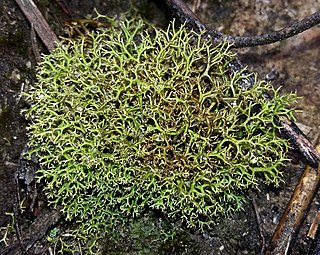
The Peltigeraceae are a family of lichens in the order Peltigerales. The Peltigeraceae, which contains 15 genera and about 600 species, has recently (2018) been emended to include the families Lobariaceae and Nephromataceae. Many Peltigeraceae species have large and conspicuous, leathery thalli. They largely occur in cool-temperate to tropical montane climates. Tripartite thalli involving fungus, green algae and cyanobacteria are common in this family.
Metus is a genus of three species of lichenized fungi in the family Cladoniaceae. The genus was circumscribed by lichenologists David John Galloway and Peter Wilfred James in 1987, with Metus conglomeratus as the type species. All three species are found in the Southern Hemisphere.

Cladia is a genus of lichen-forming fungi in the family Cladoniaceae. Cladia species have a crustose or squamulose (scaly) primary thallus and a fruticose, secondary thallus, often referred to as pseudopodetium. The type species of the genus, Cladia aggregata, is widely distributed, occurring in South America, South Africa, Australasia and South-East Asia to southern Japan and India. Most of the other species are found in the Southern Hemisphere.

Stirtoniella is a lichen genus in the family Ramalinaceae. It is a monotypic genus, containing the single species Stirtoniella kelica, a crustose and corticolous lichen originally described from New Zealand in 1873 as a species of Lecidea. The photobiont is an alga of the family Chlorococcaceae. The genus is named after Scottish mycologist James Stirton.

Degelia is a genus of lichen-forming fungi in the family Pannariaceae. The genus is named after Swedish lichenologist Gunnar Degelius.

Chiodecton is a genus of lichens in the family Roccellaceae. The genus was circumscribed by lichenologist Erik Acharius in 1814, with Chiodecton sphaerale assigned as the type species.

Anisomeridium is a genus of lichens in the family Monoblastiaceae. The type species was originally named Arthopyrenia xylogena by Swiss botanist Johannes Müller Argoviensis in 1883; in 1928, Maurice Choisy defined the genus Anisomeridium, designating A. xylogena the type species.

Punctelia is a genus of foliose lichens belonging to the large family Parmeliaceae. The genus, which contains about 50 species, was segregated from genus Parmelia in 1982. Characteristics that define Punctelia include the presence of hook-like to thread-like conidia, simple rhizines, and point-like pseudocyphellae. It is this last feature that is alluded to in the vernacular names speckled shield lichens or speckleback lichens.
Traponora is a genus of lichen-forming fungi in the family Lecanoraceae. The genus was circumscribed in 2009 by Dutch lichenologist André Aptroot, with the Papua New Guinean Traponora asterella assigned as the type, and at that time, only species. Four newly described species were added to the genus in a 2009 publication, a species formerly in Pyrrhospora was transferred to the genus in 2017, and a new species from Australia added in 2018. Traponora lichens are predominantly from Australasia, with all species but one known to occur in Papua New Guinea.
André Aptroot is a Dutch mycologist and lichenologist.
Peter Wilfred James (1930–2014) was an English botanist and lichenologist. He was a pioneer in the study of lichens as environmental indicators, especially of atmospheric pollution.

David John Galloway, FRSNZ was a biochemist, botanist, and lichenologist.
The Otago Regional Herbarium is a herbarium based at the University of Otago, in Dunedin, in the South Island of New Zealand. It has the herbarium code OTA. It has 72,000 items, making it the second largest herbarium in the South Island.
Punctelia subalbicans is a species of foliose lichen in the family Parmeliaceae. It is found in Australia and New Zealand, where it grows on the bark of various tree species.

Solenopsora is a genus of lichen-forming fungi in the family Catillariaceae. It has 15 species, with a mostly Northern Hemisphere distribution.

Crocodia is a genus of foliose lichens in the family Peltigeraceae. It has eight species. The genus has a cosmopolitan distribution, although most species occur in temperate and tropical regions of the Southern Hemisphere. The main characteristics of the genus that separate it from its parent genus, Pseudocyphellaria, include a yellow medulla and yellow pseudocyphellae on the lower thallus surface.
Gyrographa is a genus of lichen-forming fungi in the family Roccellaceae. The genus was circumscribed in 2014 by Damien Ernst and Anders Tehler, with Gyrographa gyrocarpa assigned as the type species. This lichen, originally described by Julius von Flotow in 1825, was first placed in the genus Opegrapha. Species in the genus have a crustose thallus lacking a cortex, and a dark brown prothallus. The photobiont partner is trentepholioid. The hypothecium is thick and carbonised, and the ascospores lack a gelatinous sheath; these characteristics distinguish it from Opegrapha species. The genus name alludes to the gyrose ascomata of the type species.
James Murray (1923–1961) was an organic chemist at the University of Otago. He was the first twentieth century lichenologist in New Zealand.

Robert Lücking is a German lichenologist. He earned his master's and PhD from the University of Ulm, focusing on the taxonomy, ecology, and biodiversity of foliicolous lichens. He has received numerous awards for his work, including the Mason E. Hale Award for his doctoral thesis, the Augustin Pyramus de Candolle prize for his monograph, and the Tuckerman Award twice for his publications in The Bryologist. Since 2015, he has been serving as the curator of lichens, fungi, and bryophytes at the Berlin Botanical Garden and Botanical Museum, and several lichen species and a genus have been named in his honour.
Aspiciliopsis is a genus of lichen-forming fungi in the family Trapeliaceae. It has two species, both of which occur in the Southern Hemisphere.











